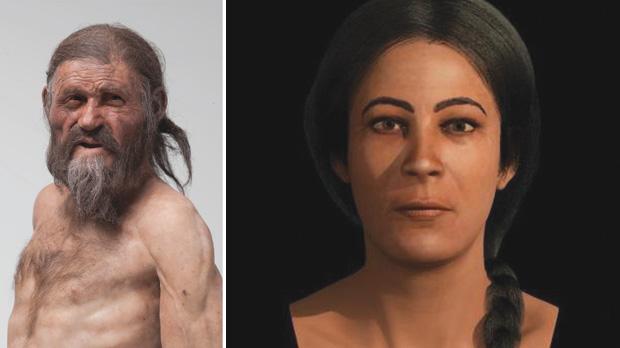
© Times of MaltaIceman. Right: Maltese prehistoric woman.
I keep looking at the reconstruction of that 5,600-year-old Maltese woman and can't get enough of her. She's got this allure which is almost intimidating, even though she's slightly cross-eyed.
If I squint a lot while looking at her picture, I can see a bit of me in her. But then I'm not the only one, it seems. Everyone was saying how much she looked like his neighbour, his girlfriend, his sister and his nanna.
A colleague said she was the split image of his wife and (romantically, I thought) wrote: "It's nice to know I'm married to a woman with such timeless beauty."
And a beauty she is this age-old woman. I can't get enough of those perfectly arched eyebrows. My groomed-when-I-remember eyebrows look prehistoric next to hers. And that perfect side-plait looks just on the right side of au naturelle.
But, as a girlfriend pointed out, the reconstructed lady from Xagħra Circle in Gozo made her debut at the Malta Fashion Week - hardly the place for excessive facial hair.
But it provoked the question: did they have tweezers? Some hoity-toities commenting online were shocked that people were being so frivolous as to ask about tweezers. Well, no it's not silly. It's actually very legitimate.
This is what brings history and archaeology close to us and not the reserve of fuddy duddies and academic buffs.
Reconstructions such as these make everyone stand up and say: "Oh. They were like us, after all." It makes us realise how our remote ancestors did not just sit at the mouth of the cave 1) with dishevelled hair pinned up with a bone 2) with a toothless gap for a mouth and 3) had blank faces and cried "Ugga, ugg, ugg" all day long.
Let's kill the myths, shall we? The hair first. When I am at home, I potter all day long with my hair in the shape of the pillow from the night before: flat on one side, and erm, bouffant on the other side.
If, however, the door bell rings, I promptly try and give it some shape - even if it's only the postman. So you can imagine that in prehistoric times - when survival of the fittest actually had a literal meaning - everyone went out of their way to preen themselves (even men).
Second myth: the rotten teeth.
Prehistoric humans didn't have toothbrushes, floss or toothpaste, and they certainly didn't have Listerine. Yet somehow, their mouths were a lot healthier than ours are today, says Alan Cooper, director of the Australian Centre for Ancient DNA.The problem started when we switched from hunter-gatherers to farmers.
The shift from meat, vegetables and nuts to carbohydrates and sugar, that's when cavities started cropping up. Therefore the prehistoric Gozitan woman probably had the strongest set of teeth ever.Third myth: they just beat on their chests and carried large stones and lounged around in a very dim manner. The truth is that they were probably much sharper and brighter than us. Professor Gerald Crabtree, who heads a genetics laboratory at Stanford University in California, believes that rather than getting cleverer, human intelligence peaked several thousand years ago and from then on there has been a slow decline in our intellectual and emotional abilities.
His argument is based on the fact that for more than 99 per cent of human evolutionary history, we have lived as hunter-gatherer communities surviving on our wits. Since the invention of agriculture and cities, however, natural selection on our intellect has effectively stopped.
"I would wager that if an average citizen from Athens of 1,000BC were to appear suddenly among us, he or she would be among the brightest and most intellectually alive of our colleagues and companions, with a good memory, a broad range of ideas and a clear-sighted view of important issues," Prof. Crabtree says.
Based on his genetic and neurobiological studies, he also put forward the idea that if we were visited by some ancient inhabitant of the world from 2,000 to 6,000 years ago, he or she would probably be more emotionally stable than us. So there we have it: we need to know more about prehistoric societies, so we learn from them.
Having said all this, I am now really interested to see who would have been the match for our prehistoric lady. Until Heritage Malta come up with a reconstruction of the Xagħra man, we can have a look at her contemporaries elsewhere. And the only reconstruction we have is that of the Ice Man, who lived in the Alps about 5,000 years ago and was found mummified.
This wiry fighting Iceman was not large by today's standards - about 160 cm and weighed about 49 kg. I keep looking at him - and you know, I think we get the douze points here - our Marija l-Għawdxija looked so much better.
Rather than award constructive ability and competence, today's legalistic society rewards the incompetent with huge sums of money, and appoints the most wantonly destructive as CEO's. The workplace is being idiot-proofed and the markets controlled by fiends.
The stage is ripe for plagues and psychopaths with dreams of world domination.
The only question is which will arrive first, the chicken or the egg?